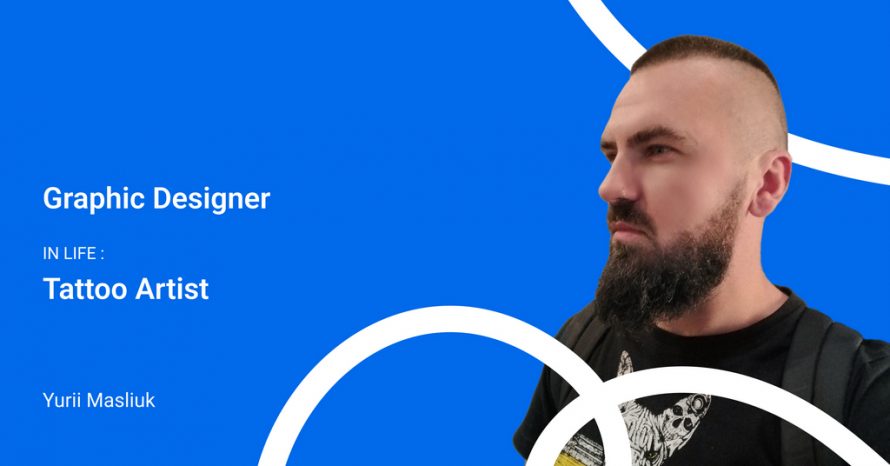Tattooing is an ancient art that existed and was popularized even before our era. However, there is still a prejudiced attitude towards this art. After all, a tattoo is imprinted for life. We spoke with Yura Maslyuk, a graphic designer at Group 107. He has been doing tattoos for many years. In this interview, Yura shared his experience and answered the most popular questions about tattoos. You will be interested, so let’s go!
Tell us about yourself
Let’s start with the fact that I have been in the company for 4 years. Back then, there was Geekapps, not Group 107. I came just to try how it is to work as a designer in the company and somehow stuck here for 4 years. In my free time, I like to draw. Also, I love basketball, but I rarely get to play because I don’t have enough time. So, apart from work and family, I read books, draw, sometimes run and play basketball.
How long have you been tattooing, and what exactly attracts you to this business?
I have been tattooing since 2015. I have been interested in this business for a long time, even at school I painted everyone with gel pens. Then my friends started encouraging me to get a tattoo. I watched for a while how the guys in my apartment make tattoos with homemade machines. For me, it took a very long time to get into this, I studied a lot. At first, it was difficult, because this is work with people, with skin and blood. It needs to be studied. I trained on artificial leather, squash, and pumpkins. I bought paints and various devices. Then I started doing real tattoos at home on the couch. Looking at old photos, I think it was terrible. However, everyone starts somewhere.
Do you need to be able to draw professionally?
In general, the sketch is can be transferred. It is printed and glued to the skin. The sketch itself remains on the skin, and you just need to circle it. I know many masters who do not know how to draw but know the basics, for example, how to apply shade. Over time, I learned how to draw in Photoshop.
Is there any school or academy for tattoo artists in Ukraine?
Now there are many schools and courses. This business can be mastered like any other profession. However, a tattoo artist is a profession that does not have any specific accreditation. All these certificates that are issued… I can do the same one, just draw it. Once upon a time, you had to go to the masters to learn how to tattoo. Now, you search for courses on the Internet, learn the main points and that’s it.
Did you learn by yourself or from a master?
I studied by myself. However, I went to the masters for sessions, and traveled and looked at tattoo exhibitions.
What to do in situations when something goes wrong, for example, if a person moves?
Depends on the tattoo. If it’s a big tattoo, you can cover everything up a little. And if it is small, then it is more difficult. Many believe that small tattoos, such as the outline of a heart, are cheap and easy to do. In fact, there is one mistake and that’s it. If your hand moves somewhere, you won’t be able to hide it. Most issues can be fixed, but it all depends on the tattoo.
How many tattoos do you have?
Personally, I don’t have many, maybe around 6. On my arm and on my ribs.
Tell us about the most painful and painless places for tattoos
Where the skin is very delicate and where there are fewer muscles, it hurts the most. In general, it does not hurt to do on the shoulders, hips, back, on shoulder blades, but it all depends on the person. Everyone has their own expectations from that process, someone may not adjust well. Some people tolerate it calmly and say they do not hurt, even those places that are usually considered painful. And some can panic and lose consciousness from a tiny needle bite.
Where are tattoos most often?
Women usually get small tattoos on their wrists, forearms, collarbones, shoulders, thighs, and lower legs. Men are more on the shoulders, chest, back, calves and thighs.
Have you tattooed a military person in the last six months? What do they usually want to draw?
Most often it is something patriotic. I don’t even include coats of arms and flags in my portfolio anymore, because there are already thousands of them. I display something more interesting, like Cossacks or something else… Sometimes the military wants something religious – Jesus, a crucifix, or doves. Also, predatory animals, such as lions, tigers or wolves. It is obvious that warriors will want themselves something aggressive or combative.
Are there any types of stuffing tattoos, techniques, or styles?
I personally work with all styles except color realism. I don’t really like colored tattoos. Tribal/ethnic tattoo style is fantastic. I like styles that existed even before the new era. I like tattoos that are part of the culture of some tribes, Vikings, and ancient Slavs. Furthermore, I also like something traditional or old school. There are also tattoos that American sailors brought with them. During their travels, they made such primitive drawings that could be filled right on the ship or in the port quickly. I like the graphic style. It contains many sub-styles: whip shading, dotwork, linework, sketch geometric – these are all styles that can be used to display some objects or characters quite beautifully and voluminously. I like the Japanese style, but it is also kind of an ethnic, traditional style of tattooing in Japan. However, it, unfortunately, has a negative character, because they associate it with the yakuza. In Japan, by the way, not long ago, tattooing was recognized as legal, before that it was illegal. Neo-traditional or new school. It is like old school but has clearer contours, smoother. Transitions are brighter, similar to a realistic style. Black and white realism is the style that impresses me the most. And also, watercolor, biomechanics, ornamentation, or simply black skin. Now a lot of people are doing various collaborations of styles, which looks quite interesting. I work in most of these styles.
Many people say that it is more difficult for a tattoo master to cover the hand with black paint than to stuff some drawings. Is this true?
It depends on the master. For me, for example, it is easier to draw an eagle on the shoulders than to draw a thin line along the whole arm. Making a gradient fill is somehow easier than just black. It all depends on the master and the style, that is, if you see a master doing only black and white on Instagram, it is better not to go to him for watercolor. There are also masters who do lettering only, so it is better not to go to them for a portrait. To each his own.
What was the longest time you worked on a tattoo?
If we talk about one person, it is 15 hours with lunch breaks. They made a phoenix from the ribs to the knee. I drew that picture for a girl who was supposed to go to Poland. The longest time I worked on one tattoo was about 20 hours. It was about 5 sessions in a row.
What are the types of devices and techniques for tattooing?
From the point of view of tattooing techniques, you can do it by hand, for example. Now it’s called hand work – it’s when the master just takes one needle and stuffs it by hand. This method dates back to the ancient peoples and tribes, who filled tattoos with fish bones and needles from trees. Now there are special tattoo needles and masters use them for work. There are also modern machines. There are different lengths of needles. For contours, the needle is thin, for painting, there are interconnected needles that go in two rows in a checkerboard pattern.
Are there any methods for tattoo care?
Now, 50% of tattoo quality depends on the client. Each master should give some recommendations for healing because they differ for some. I, for example, use a special film for small works that simplify the work of the tattoo owner. You can just walk with it for 4 days, then take it off, wash it off, and apply a special healing ointment for a week. It is also necessary to comply with simple conditions, such as: not going to the sauna, swimming pools, and places where you can pick up something. Do not sunbathe and do not drink alcohol. Tattoos usually heal in 2-3 weeks.
How to choose a tattoo artist?
I would advise you to look at the portfolio. I also recommend coming for a consultation, looking at his workplace, and asking the following questions: how does he work, does he use disposable needles, and how does he clean the place when you are there, or before your arrival? I, for example, try to make sure that the client sees that everything is new. Likewise, I pour paint next to the client or unpack new needles.
What can you advise a person who wants to get a tattoo?
For those who already have tattoos, I can advise them to be proud of their tattoos, to look for new ideas, to please the masters with their ideas, to mark some dates on their body, and to dedicate the tattoo to someone.
Want to join us? We always welcome newcomers, so we invite you to join us for an internship. Start your IT career today!


